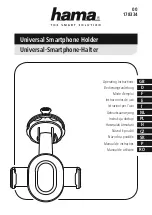
209
APPENDIX
12. Where can I find additional information?
For additional information, please refer to the following resources:
x
For FDA web page on wireless phones, Visit http://www.fda.gov/Radiation-EmittingProducts/
RadiationEmittingProductsandProcedures/HomeBusinessandEntertainment/CellPhones/default.
htm)
x
For Federal Communications Commission (FCC) RF Safety Program,
Visit http://www.fcc.gov/oet/rfsafety
x
For International Commission on Non-Ionizing Radiation Protection,
Visit http://www.icnirp.de
x
For World Health Organization (WHO) International EMF Project,
Visit http://www.who.int/peh-emf/en/
x
For National Radiological Protection Board (UK),
Visit http://www.hpa.org.uk/radiation/
AVOID POTENTIAL HEARING LOSS
Prolonged exposure to loud sounds is the most common cause of preventable hearing loss. Some
scientific research suggests that using portable audio devices, and cellular telephones, at high volume
settings for long durations may lead to permanent noise-induced hearing loss. This includes the use of
headphones (including headsets, earbuds and Bluetooth® or other wireless devices). Exposure to very
loud sound has also been associated in some studies with tinnitus (a ringing in the ear), hypersensitivity
to sound and distorted hearing. Individual susceptibility to noise-induced hearing loss and other
potential hearing problems varies.
The amount of sound produced by a portable audio device varies depending on the nature of the
sound, the device, the device settings and the headphones. You should follow some commonsense
recommendations when using any portable audio device:
x
Set the volume in a quiet environment and select the lowest volume at which you can hear
adequately.
x
When using headphones, turn the volume down if you cannot hear the people speaking near you
or if the person sitting next to you can hear what you are listening to.
Содержание ADR8995
Страница 170: ...170 TOOLS Sample skins...














































